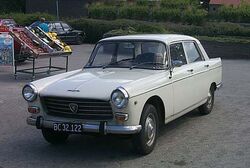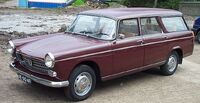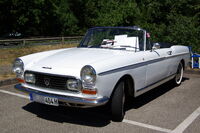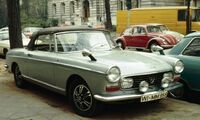 | |
| Manufacturer | Peugeot SA |
|---|---|
| Production |
1960–1975 (Europe)[1] until 1991 (Kenya) |
| Predecessor | Peugeot 403 |
| Successor | Peugeot 504 |
| Class | Large family car |
| Body style(s) |
4-door sedan 5-door estate 2-door coupé 2-door convertible 2-door pickup truck |
| Layout | FR layout |
| Engine(s) |
1.6L I4 1.9L diesel I4 |
| Transmission(s) |
4-speed manual 3-speed ZF automatic |
| Wheelbase | 2,650 mm (104.3 in) |
| Fuel capacity | 11 imp gal (50 L/13 US gal)[2] |
| Designer | Pininfarina |
The Peugeot 404 is a large family car produced by French automobile manufacturer Peugeot from 1960 to 1975, with the exception of the truck which was sold until 1988. It was also made under licence in various African countries until 1991 (in Kenya).
Designed by Pininfarina, the 404 was offered initially as a sedan, estate, and pickup. A convertible was added in 1962, and a coupé in 1963. The 404 was fitted with a 1.6 L petrol engine, with either a Solex carburetor or Kugelfischer mechanical fuel injection or a 1.9 L diesel engine available as options. Introduced at the Paris Motor Show as an option was the inclusion of a 3-speed ZF automatic transmission, similar to the unit already offered on certain BMW models,[3] as an alternative to the standard column-mounted manual unit.
Popular as a taxicab, the 404 enjoyed a reputation for durability and value. Peugeot's French production run of 1,847,568 404s ended in 1975. Still relatively common in developing nations (especially in pickup form), an additional 2,885,374 units were produced under license until 1988.
Production history[]
Year 1960[]
Sedan introduced with 72 hp petrol engine and column-shift 4 speed gearbox with gate "reversed" (1st down, up for 2nd and towards the wheel for 3rd down and 4th up) – identical to the 203 and 403 (except that 4th gear is direct drive). Grand Touring model has square air vents on the dashboard and body-coloured wheels.[4]
Year 1961[]
Introduction of Super Luxe model: Superstructure painted silver, chrome headlight rims, large diameter hubcaps, tan leather interior trim, front armrest.[4] Grand Touring model has body colour wheels replaced with metallic silver ones.[5]
Year 1962[]

Peugeot 404 familiale (1968 model shown)
New suspension with increased travel and flexibility.[5] Dashboard is modified and square air vents are replaced by circular directional vents. New reinforced drum brake linings. Anti-reflective paint used for the dashboard.[4]
Introduction of Commercial, Break and seven-seat Family estate versions, with tandem coil spring rear suspension in the place of the sedan's single spring arrangement. These versions have a balanced spring system to assist in opening the tailgate, different rear light clusters, rear bumper arrangement and the fuel filler cap is no longer hidden behind the rear number plate, but behind a flap in the rear wing. These variants are also longer (4,590 mm (181 in) vs 4,445 mm (175 in)) and heavier (1,190 kg (2,624 lb) vs 1,100 kg (2,425 lb)) than their saloon equivalents.[5]
Convertible launch[]

Peugeot 404 Cabriolet 1968
The coupé and convertible bodyshells are made by the Pinin Farina workshops in Turin. Only the floorpan and mechanical elements are common to the sedan. The convertible is available from launch with the option of a fuel injection engine (XCKF1). The accompanying coupé version was launched six months later.[4]
Year 1963[]
The 404 Super Luxe sedan is available with the 85 hp fuel injection engine and has door cappings trimmed with leather. The 404 Grand Touring sedan adopts painted side window trims instead of chrome. The steering wheel and horn ring change.[4] The Family estate gains a split middle row of seats to improve access to the rear row.[5]
Year 1964[]
The sedan carburetor engine adopts 5 bearings (XC5), as does the injection (XCKF2). Launch of the 404 diesel with Indenor engine (XD85), which is quickly replaced by the engine XD88, having a more powerful and reliable Bosch pump. Rubber over-riders fitted on the bumper. Bi-colour oval front indicator clusters fitted on coupés and convertibles (a similar design will be used later on sedans and derivatives).[4]
Year 1965[]
XCKF2 injection engine power increased to 96 hp.
XC5 carburettor engine power increased to 76 hp. Thermostable "Hydrovac" brakes servo-assisted by a mechanical vacuum manufactured by Bendix. The Super Luxe, coupé and convertible get eight-hole wheel covers cells instead of six-hole ones. New seat pads for Grand Touring, with cloth quilted to form longitudinal ridges similar to the 404 Super Luxe.[4] All models are given reclining front seats.[5]
Year 1966[]
The Grand Touring sedan is available with the XCKF2 injection engine. It was also available with a ZF automatic gearbox. The front indicator light clusters are now orange / white on all models. Two tone door linings (black top and bottom) on all models. Cigarette lighter fitted on Super Luxe only. Brake compensator fitted on petrol models.[4]
Year 1967[]

Cabriolet showing later style grille and indicator clusters
XC6 carburetor engine fitted with increased power of 80 hp. Rear anti roll bar fitted. New dashboard with 3 round dials, steering wheel is no longer adjustable. The spare wheel is relocated from inside the boot to under rear of the car. The rear valance is amended (Sedan only) and the capacity of the petrol tank is increased from 50 to 55 liters (sedan). Cigarette lighter fitted on all models, Super Luxe has automatic light on lockable glovebox. The front of coupés and convertibles is redesigned, incorporating a new grille with integral driving lamps and rectangular indicator clusters. The convertible hood now has a "Panoramic" rear window and the seat mechanism is improved for better accessibility.[4]
Year 1968[]
A 404 (8hp) Comfort model is added to the range, having an identical 1468cc engine displacement to the old 403 (although the engine is not from the 403, but derived from the larger XC6 unit). It is an economy model, fitting into a lower French puissance fiscale (road tax) class than the 9 hp version. It has the former dashboard and bumpers without over riders. This is also the first model to benefit from front disc brakes. 8 hp cars are not imported into the UK, but some RHD models are produced for other markets.[6]
Reversing lamps are fitted to Super Luxe. New gearbox with European grid (BA7) fitted on all models in place of "C3" box. New steering wheel, dashboard modified.[4]
Year 1969[]
Peugeot launches the 504. 404 injection no longer offered, new door interior panels introduced. Disc brakes fitted on all petrol models.[4]
Year 1970–1972[]
In 1970, the 404 Super Luxe and 404 (8 hp) Comfort are discontinued, leaving the Grand Touring, Break and Family models to continue in petrol and diesel forms. The Grand Touring receives chrome headlight rims and reversing lights as standard. Wing-mounted indicator repeaters are no longer fitted. New XC7 engine fitted (de-tuned to 73 hp), but with torque equivalent to XC6.
New front indicator clusters from 1971. 2-speed windscreen wipers introduced on the sedan 1972, with optional rear screen demister.[4]
Year 1973–1975[]
Water temperature gauge is replaced by warning lamp on dashboard, grille shield is replaced by lion. The optional automatic transmission (which is now 6 positions: PRN 3 2 1) is available until the end of 1974. In 1975, production of European passenger models ceased.[4]
Foreign assembly[]

Three Peugeot 404 pickups in Tunisia, still in use in 2011

Argentine Peugeot 404 pickup (1973-1979)
The 404 was assembled in a number of countries besides France. It was manufactured by Safrar in Argentina (later Sevel) (162,583 cars built), and assembly took place in Australia (by the local Renault subsidiary – 8600 cars built), Belgium, Canada (about 3100 404 sedans were built at the SoMA plant shared with Renault), Chile (14,892 cars built), Ireland, Kenya, Madagascar, Malaysia, New Zealand (2800 cars built), Nigeria, Portugal, Perú (by Braillard[7]), Rhodesia, South Africa (79,045 cars built), and Uruguay.[8]
In South Africa, where the 404 saloon continued in production until the end of 1978, the GL and Automatique versions received the more powerful 1.8-litre (110 cu in) XM7 engine also used in the 504.[9] The GL also received front seats similar to those of the 504, as well as the 504's floor-mounted shifter with its characteristic bend. Late cars also have 504 steering wheels, as 404 parts were becoming scarce. The 404 Wagon was assembled until early 1976, when the supply of French CKD kits dried up.[10]
The 404, especially in pickup form, is still a common sight in North and West Africa. The Argentinian-built 404 was available with both the 1.6 petrol and the diesel engine, in Standard or Luxe equipment levels. The Luxe featured sporty alloy wheels and a special grille with integrated extra lamps.[11]
Technical specifications[]
- 8 tps petrol: 1 468 cc (60 PS (44 kW/59 bhp)) (discontinued 1969/70)[1]
- 9 tps petrol: 1 618 cc for carbureted models (72 PS (53 kW/71 bhp)) or injection (85 PS (63 kW/84 bhp) at 5 500 r / min), economy: 10.8 litres/100 km (26 mpg)
- 8 tps Diesel: 1 948 cc (64 PS (47 kW/63 bhp)).
- Transmission: clutch disc or semi-automatic (Jaeger electromagnetic coupler) or automatic (ZF).
- Suspension: Coil springs with hydraulic shock absorbers front and solid axle with Panhard rod at rear.
- Maximum speed: 167 km/h (104 mph) (fuel injection)
Road tests and press reviews[]
404 coupé injection[]
The 404 coupé with the desirable "KF2" fuel injected engine was tested by Motor magazine on December 4, 1965. The title of the article is "A First Class Job" and the rest of the article follows suit, mostly with praise for the car's remarkable performance and beauty. Even with 415 lb (188 kg) of driver and test equipment on board, the car posted a 0-60 mph (97 km/h) acceleration time of 12.2 seconds, 18.8 seconds in the standing start 1/4 mile and a top speed of 105.2 mph (169.3 km/h). Fuel economy (over a shorter test distance than usual) was 23.8 miles per imperial gallon (11.9 L/100 km/19.8 mpg-US), which the author suggests would have improved had the usual test distance been completed. The punitive British taxes of the 1960s made this a very expensive car indeed, equivalent in cost to a Jaguar Mark X. Overall the conclusions of the review were excellent.[12]
404 saloon[]
The 404 saloon was tested by Motor magazine in 1968. The styling was criticised as square cut, perpendicular and appearing rather dated, while the interior was considered "austere" compared to British cars of the time (the article includes a performance comparison with the Triumph 2000, Ford Corsair 2000E and Humber Sceptre). However, great praise is given for build quality, with the article stating that the car is suitable for African safaris and Arctic gales alike.[13]
404 Familiale[]
The 404 was tested (in Family estate form) by Motor magazine in 1965. The car's quirks (the unusual original column-shift gearbox gate and awkward body roll at low speed) are listed. Build quality was praised and the interior described as "quietly tasteful", although the authors felt that the appeal of the car was limited.[14]
The car was tested again by Motor magazine five years later. The article is critical of the car's styling, calling it "square cut" and "hardly avant garde", but then relents and opts for "mature rather than dated" as its final comment. The ride is reported to improve as loading and speed increase. Of some concern to the testers was the driver's difficulty in reaching the handbrake when wearing a fixed seat-belt – inertia reel type belts would not have this problem. Alternative cars were listed as the Citroen Safari and Volvo 145. The car is described as having been used by one reader to transport the driver and 12 children.[15]
An article in The Times newspaper on French-made cars includes a comparison of the outgoing 404 with the 504. The performance of both cars (given their engine size) is praised.[16]
404 Diesel[]
During the 1960s Peugeot, along with Mercedes-Benz, were pioneering large scale production of diesel engined passenger cars. The British "Autocar" magazine tested a Peugeot 404 Diesel in November 1965. The car had a top speed of 81 mph (130 km/h) and accelerated from 0-60 mph (97 km/h) in 25.5 seconds. An "overall" fuel consumption of 32.2 miles per imperial gallon (8.77 L/100 km/26.8 mpg-US) was recorded. This compared with a top speed of 88 mph (142 km/h), a 0-60 mph (97 km/h) time of 20 seconds and an overall fuel consumption of 32.2 miles per imperial gallon (8.77 L/100 km/26.8 mpg-US) for the petrol version of the car which had recently been tested by the same journal and which (albeit without the diesel car's a rev limiter) had exactly the same gear ratios. In terms of performance the Peugeot comfortably outperformed the diesel Austin Cambridge and the Mercedes Benz 190D also included in the comparison. The slower Austin nonetheless won on fuel economy. In terms of price, the 404 diesel was offered in the UK at £1,396 as against £1,093 for its petrol fuelled sibling. The manufacturer's recommended price for the Austin was just £875. The slower heavier Mercedes was not really pitched at the same market segment, being priced in the UK at £2,050. The testers described the Peugeot 404 Diesel as 'the fastest diesel yet'. They reported the characteristic diesel rattle when idling and the 'roar at high revs', but found the performance 'very reasonable'. They commended the sure-footed road holding, good steering, powerful fade-free brakes, the comfortable seats, the very good fuel economy and the prospect for a 'long attention-free life'.[2]
The 404 Diesel was tested again (in Family estate form) by Autocar magazine six years later. Top speed was improved on the previous test, 82 mph (132 km/h), but acceleration to 60 mph was poorer at 26.8 seconds. Notable features in the report were that the test car had broken two speedometer cables during testing. They mention its size twice: "wonderfully roomy" and "a big car for big men". The cars "oddities" are listed as the reverse-acting gearbox gate, window-sill door locks and windscreen wiper controls.[17]
Racing[]
Peugeot 404s won the Safari Rally in 1963, 1966, 1967 and 1968, the latter three in Kugelfischer fuel-injected variants.
References[]
| This page uses some content from Wikipedia. The original article was at Peugeot 404. The list of authors can be seen in the page history. As with Tractor & Construction Plant Wiki, the text of Wikipedia is available under the Creative Commons by Attribution License and/or GNU Free Documentation License. Please check page history for when the original article was copied to Wikia |
- ↑ 1.0 1.1 "Changes during building period". 404.tin.at. Retrieved on 2008-06-28.
- ↑ 2.0 2.1 "Autotest – Peugeot 404 Diesel", Autocar: pages 1133–1137. date 26 November 1965.
- ↑ "Behind the glitter of Paris: Show Report", Car Magazine: pages 27–30. December 1965.
- ↑ 4.00 4.01 4.02 4.03 4.04 4.05 4.06 4.07 4.08 4.09 4.10 4.11 4.12 "404 Production (in French)". www.leclub404.com. Retrieved on 2009-09-01.
- ↑ 5.0 5.1 5.2 5.3 5.4 "évolution de 404 1960–67(in French)". 404peugeot.free.fr. Retrieved on 2009-09-01.
- ↑ Club Peugeot UK – 404 page
- ↑ "Newsletter 10-2011".
- ↑ Cite error: Invalid
<ref>tag; no text was provided for refs namedWC72 - ↑ Wright, Cedric, ed. (August 1978), "Passenger cars - Vital statistics", CAR (South Africa) (Ramsay, Son & Parker (Pty) ltd.) 22(7): 141–142.
- ↑ Howard, Tony (October 1976), "Peugeot's 'Economy' 504", SA Motor (Cape Town, South Africa: Scott Publications): 22.
- ↑ Costa, André & Georges-Michel Fraichard, ed. (September 1980), "Salon 1980: Toutes les Voitures du Monde" (in fr), L'Auto Journal (Paris: Homme N°1) (14 & 15): 225. M1117.
- ↑ "A First Class Job", The Motor. date 4 December 1965.
- ↑ "Gum-booted refinement Motor Test 10/68", The Motor. date 9 March 1968.
- ↑ "Peugeot Family Estate Motor Test 19/65", The Motor. date 8 May 1965.
- ↑ "Car comfort, minibus load Motor Test 26/70", The Motor. date 27 June 1970.
- ↑ "Built to do the donkey work", The Times: Supplement, page III. date 13 March 1973.
- ↑ "Brief Test Peugeot 404 Family Estate (diesel)", Autocar: 16–17. date 8 July 1971.
External links[]
- Eugenio's Peugeot 404 site – contains manufacturer's promotional photographs
- Martin Brunner's Peugeot 404 site – contains photographs and media not available on Wikipedia (manufacturer publicity material)
- Dirk Mueller's Peugeot 404 site (German and English) – contains photographs and media not available on, or unsuitable for Wikipedia (primary source material, copyrighted drawings and photos)
- Le site des fanas de 404 (French) – contains technical information and photographs not available on Wikipedia
- technical information about Peugeot 404 (French) – contains manufacturer's original literature (primary source material)
- Phil Seed's Virtual Car Museum – Peugeot 404 – contains promotional photographs of final facelift
- 404 page in Coche Argentino - history and technical data about the 404 made in Argentina
| « previous — Peugeot, a marque of PSA Peugeot Citroën, road vehicle timeline, 1940s-1970s — next » | |||||||||||||||||||||||||||||||||||||||||||||||||
|---|---|---|---|---|---|---|---|---|---|---|---|---|---|---|---|---|---|---|---|---|---|---|---|---|---|---|---|---|---|---|---|---|---|---|---|---|---|---|---|---|---|---|---|---|---|---|---|---|---|
| Type | 1940s | 1950s | 1960s | 1970s | |||||||||||||||||||||||||||||||||||||||||||||
| 0 | 1 | 2 | 3 | 4 | 5 | 6 | 7 | 8 | 9 | 0 | 1 | 2 | 3 | 4 | 5 | 6 | 7 | 8 | 9 | 0 | 1 | 2 | 3 | 4 | 5 | 6 | 7 | 8 | 9 | 0 | 1 | 2 | 3 | 4 | 5 | 6 | 7 | 8 | 9 | ||||||||||
| Supermini | 104 | ||||||||||||||||||||||||||||||||||||||||||||||||
| Small family car | 202 | 202 | 203 | 204 | 305 | ||||||||||||||||||||||||||||||||||||||||||||
| 304 | |||||||||||||||||||||||||||||||||||||||||||||||||
| Large family car | 402 | 403 | |||||||||||||||||||||||||||||||||||||||||||||||
| 404 | |||||||||||||||||||||||||||||||||||||||||||||||||
| 504 | |||||||||||||||||||||||||||||||||||||||||||||||||
| Executive car | 604 | ||||||||||||||||||||||||||||||||||||||||||||||||





